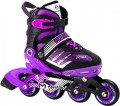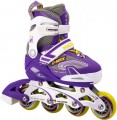The way the wheels are placed on the frame of the rollers.
—
Inline. Such roller skates are somewhat similar to traditional skates — only instead of a blade, each boot has a frame in which the wheels are fixed, one after the other. This option is by far the most popular — it is considered suitable for creating roller skates for any style of riding(see above) and allows for almost any number of wheels (from two or more). At the same time, the ride itself is not too difficult and accessible even to beginners. The main disadvantage of inline roller skates is poor lateral stability. However, this drawback is very conditional and may turn out to be critical only for the smallest riders, and its reverse side is good manoeuvrability and suitability for high speeds.
—
In pairs (quads). Roller skates are equipped with 4 wheels mounted in pairs, in the form of a rectangle (similar, for example, to car wheels). The most obvious advantage of this option is its excellent lateral stability, which significantly reduces the likelihood of falls compared to wheels installed inline, and makes it easier to perform “dance” moves on roller skates.
— Back in pairs(diamond-shaped). It is a kind of compromise between the inline and quad roller skates described above. This design, usually, provides a conventional single-row frame. However, twin wheels are installed on the rear axle instead of one co
...nventional one. Thanks to this, the rollers are noticeably superior to the quad models in terms of manoeuvrability, and the inline ones in lateral stability. However, in general, they are considered a training option — for those who would like to learn how to ride inline roller skates, but for one reason or another cannot immediately start with them. Also note that in many of these models, it may be possible to install wheels inline.
